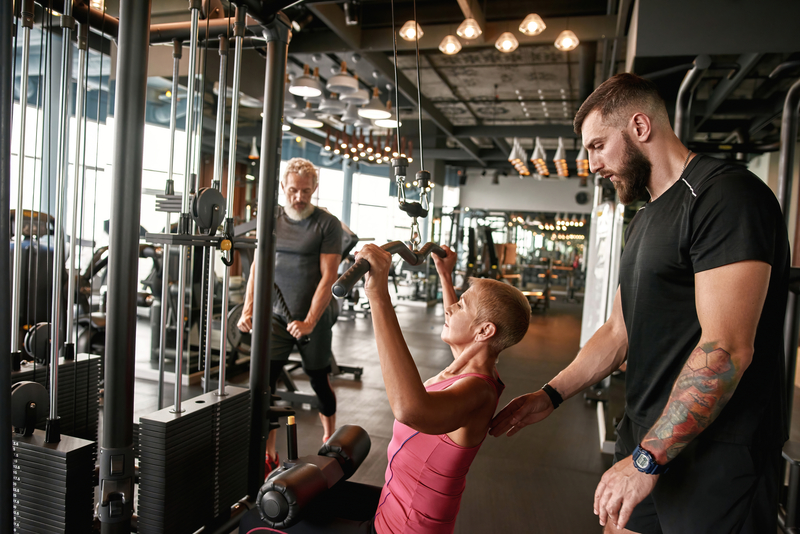When Should You Increase Your Weights in the Gym?

Now that you’ve been faithfully doing your cardio and resistance training, you feel like you’re ready to lift heavier weights. How do you know when it’s time to increase your weight, and how can you do so safely? It’s easy when you follow a few straightforward strategies.
How to Start
After you’ve been working out for a while, you’ve got things pretty much handled. However, you’ve hit plateaus with your weight loss and muscle building. What could be the problem?
Most likely, you’re stuck in a rut, and it’s time to push yourself harder and lift heavier weights. You see, your body is a well-oiled, finely-tuned machine. This is great, except for the fact that it adapts to the stressors placed on it.
That means, if you’re always lifting the same weights, eventually you’ll stop making any real progress because your body will get stronger to accommodate the weight you’re using.
In other words, your body gets bored after you’ve been working with the same resistance for a while, and your progress will start to slow down if not stop altogether. You have to challenge yourself with more resistance if you want to continue to make gains. And you want to make progress with your fitness, right?
Why You Should Lift Heavier Weights
Making progress: that’s where lifting heavier weights comes into play. Why? Because, as mentioned, your body adapts to the weights you lift. So, eventually, you’ll get better and better at lifting the weight (which is great), but you won’t build more muscle or get stronger.
To add and strengthen muscle tissue (which is a lifelong, ongoing project), it’s important to progressively challenge yourself. You do that by periodically and strategically increasing the amount of weight you use.
Take these Steps to Lift Heavier Weights in the Gym
Examine Your Goals—what is your objective in terms of your fitness and weight lifting? Are you trying to tone up? Maybe you want to get stronger? Or, are you trying to increase muscle mass? Your endgame will help you determine your steps along the way and when, exactly, you need to lift heavier weights to achieve your goals.
For example, if your goal is to build muscle, you’ll want to be in the 8- to 10-rep range. If your goal is to get stronger, aim for the 5- to 6-rep range. For toning, do 15 or more reps.
Start with a Baseline—the first thing you need to do is figure out your starting points. Go through your routine and figure out how much you can comfortably lift for each exercise now. If you’re doing 15 repetitions and it’s easy, you’re probably ready to move up in weight. Make a note of your current exercises, weights, and repetitions.
Keep a Journal—now this is truly essential for real progress. You want to know how much you lifted for how many repetitions for each exercise for every body part. Keep track of this on a workout-by-workout basis. Each time you work that muscle group, try to go slightly heavier or get one or two more repetitions. This is called “progressive overload” and will help you in your quest to lift heavier weights.
Watch Your Form—this is probably your number one indicator as to when you’re ready to kick it up a notch. Basically, if you can’t use perfect form with the resistance you’re using now, then you’re not ready to move up in weight. Focus on perfecting your form and getting the most out of each repetition. Once you can do 12 – 15 repetitions (or whatever the rep range is for your fitness goals) with perfect form, you’re ready to move up in weight.
Move Up in Weight Slowly—you want the weight to be liftable but get really heavy toward the end of your set. For example, if your goal is 12 repetitions, you’ll want reps 6 through 8 to be hard to do and then almost impossible to lift around rep number 12. This scenario means your muscles are being challenged. Keep track of this number, and when those last few reps start getting easier or you can push out a few extra reps, it’s time to move up in weight.
What Happens if You Can’t Go Heavier with Your Weight?
If you can’t go heavier (yet), there are still ways you can challenge yourself.
Go slower—try a very slow tempo for the negative portion of the movement. This is hard to do and will help you get stronger.
Try drop sets—if the next weight up is a five-pound jump and it’s too much, try lifting that weight for one or two reps (or until failure) and then drop down to a weight you can comfortably lift. Finish out your set with that weight. Or, if you’re super motivated, drop down a third level and do as many reps as you can with that even lighter weight.
Take shorter rest periods—instead of resting two minutes between sets, take a quick breather and jump right back into it.
Superset—or, take no rest and do back-to-back sets of different exercises without resting between exercises.
Or, mix it up. Aim to lift heavier weights on some days and do slow repetitions, drop sets, or supersets on others. Whatever you do, don’t always do the same thing.
Mixing it up, pushing your limits, and progressively increasing your weight over time will help you build muscle and get stronger. Remember, once it gets too easy, you’re not getting as much out of your efforts, so start to lift heavier weights and push your muscles to jumpstart your progress again.



 7 Signs Your Body is Seriously Low on Collagen (not just wrinkles)
7 Signs Your Body is Seriously Low on Collagen (not just wrinkles) Health Expert: "Turmeric Doesn't Work (unless...)"
Health Expert: "Turmeric Doesn't Work (unless...)" 3 Warning Signs Your Probiotic Supplement is a Total Waste
3 Warning Signs Your Probiotic Supplement is a Total Waste

